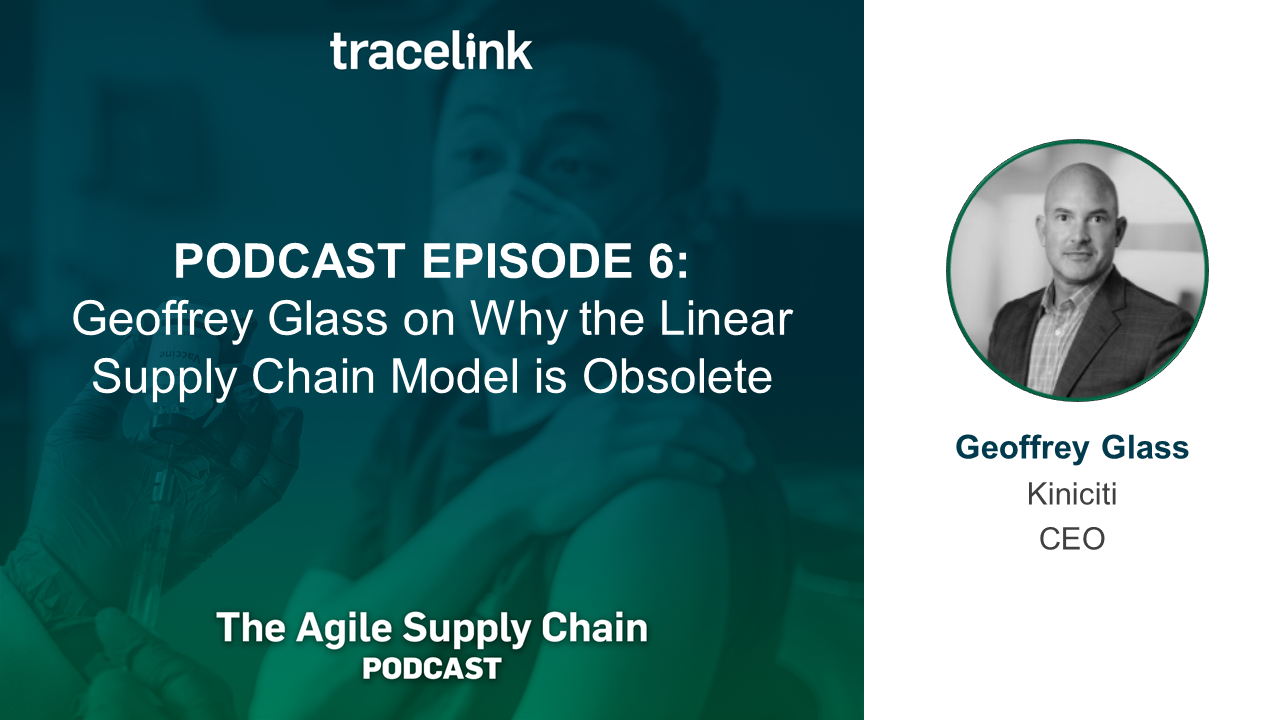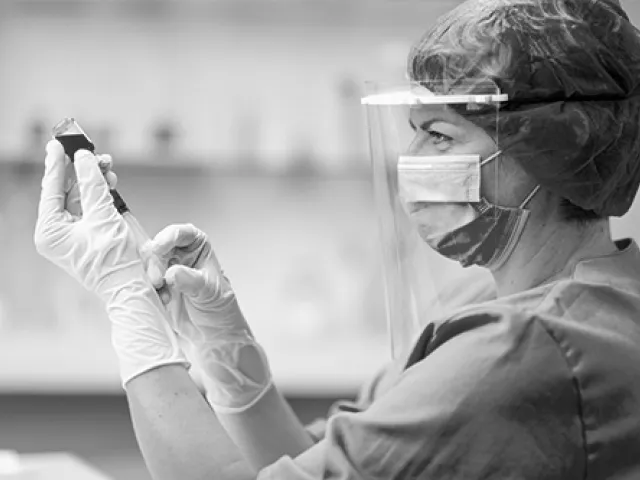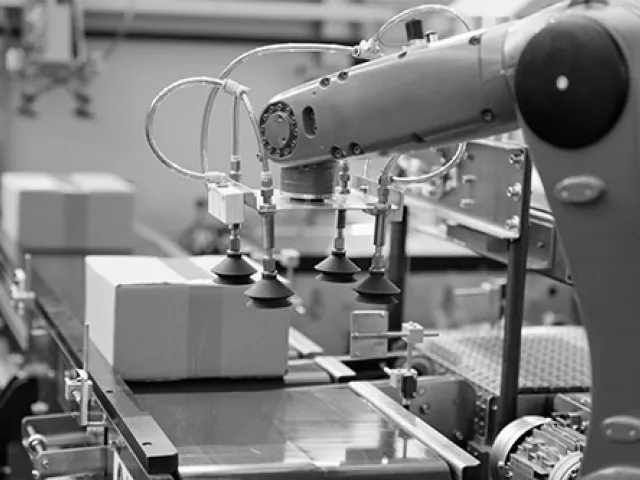Table of contents
Key Takeaways
- COVID-19 has prompted a rethink of supply chain sourcing strategies.
- To achieve supply chain agility, you must first achieve resilience.
- The mental model of the supply chain is shifting to "patient-back," and that has major implications if you're striving for agility.

TraceLink's Roddy Martin talks to pharma supply chain leader Geoffrey Glass about redundancy, flexibility, and why the traditional linear supply chain is obsolete.
Transcript:
Roddy Martin: Geoff, welcome to the thought leadership session series that we're putting together at TraceLink. I really welcome having you on this. You and I go back a long time from the days when you were involved and weighed down in the depths of MESs and batch records.
Now that you are investing, you're leading, and have been CEO of a biotech company and involved in cell and gene therapy, it's obviously a massive rise. I'm really curious. Introduce yourself, talk a little bit about your roles, and how you've seen the supply chain evolve in importance.
If you can just play on this issue of agility, we don't want to dwell on COVID‑19, but the point is building agility and resilience in the supply chain is fundamental for healthcare. Give us some perspectives on that and we'll see where the discussion goes, but welcome. Thank you.
Geoff Glass: Thank you, Roddy and to the entire TraceLink team, for having me on board. Yeah, I certainly was reflecting back. I have been in the biopharma space for 25 years, spent nearly the first 10 in management consulting with Ernst & Young when you and I met each other.
It was back in 1997 when I was on the commissioning team for Genentech's first facility out of South San Francisco in Vacaville and we implemented the first electronic batch record in North America, which was groundbreaking at the time. When you reflect back on it now, it's quite different.
Over 25 years, I've spent time in management consulting. I've been in leadership roles in therapeutics companies. I've been in leadership roles at services companies, spent nearly seven years as an officer at Patheon.
As you said, I've run some small therapeutic drug delivery companies. I'm currently an operating partner for Longview Capital and I'm also a chairman of a public therapeutics company, Avadel Pharmaceuticals.
I guess the unique perspective that I've got is starting in consulting, you see a lot of transformation change in investments and I've balanced both on the therapeutics and the services side. One of the things that I think is important to the theme that you're focusing on with agilities, if you think about the industry, and rewinding back to those times.
Whether it's a mid‑'90s or even the early 2000s, drug development in the life science's space was really focused on investing in molecules, and focusing on the clinical and medical thesis that those molecules had.
You had disproportionate focus by VCs. Companies got started, first person they hired was a chief medical officer, everything was about running into the clinic scene, that first activity in man. CMC (Chemistry, Manufacturing, and Controls), which is at the heart of supply chain for the drug industry...It's an afterthought for a long time.
As we started funding more drugs into the clinic and you had the big boom in biotech, which we're living in the biggest boom time of funding certainly of my lifetime, you had a lot of missteps that weren't related to the medical activity or safety of the drugs.
Missteps in shortcuts around supply chain, as you said, whether that's drug substance, whether that was drug product, whether it was laboratory or other methods, and it took the industry some learnings through these failures.
You can track this very clearly with a number of CRLs (Complete Response Letters) rather than approvals the companies got that were CMC‑related and had nothing to do with the medical side. Certainly at Patheon, when I was there, we saw this clearly because we were offering development in manufacturing services.
I think that shift has helped put the lens for the industry on this supply chain issue. Over time because of those learnings, you've had CMC rise to more prominence and how companies structure themselves. They staff themselves, it's not the last person hired for the biotech, as an afterthought, they're coming in earlier.
It's starting to be a focus of what are the budgets and what are the investments that boards are looking at for companies. Do you have one API supplier? Do you have multiple sources of supply? Do you have one drug product?
It was standard protocol going back probably even five years that these small biopharmas, they would never qualify a second source for either of those prior approval. Now boards are having tough conversations, saying, "Why is that?"
Roddy: I think it's obvious. It's a pointed question.
Do you think that COVID and the fact that we suddenly woke up and we realized, "Oh my goodness, we can't get acetaminophen because it's made in a particular country. Now we can't get it out of that country," or there's a certain drug where they're going to limit exporting to other countries because they want to keep it for themselves?
Do you think that COVID and the pandemic has really shone a light on things like the risks of outsourcing and offshoring, and a lot of the re‑shoring will happen just to reduce the risks in the end‑to‑end supply chain?
Geoff: I look at the issues a little differently. I bifurcate between domestication of supply chains, which I think is a different kettle of fish, then in just having agile, flexible supply chains.
I just think about COVID as...It's simply a supply chain disruption, which has people then look at their supply chains and say, "Why am I single‑threaded if I am?" It's game over if I have a disruption versus, "If I had planned for more flexibility and more risk management," which obviously has got a cost, but it's got a benefit.
I'll give you the perfect example. This is going way back into my consulting days when I was running Amgen as an account for Ernst & Young. Enron, which ended up being a big blow‑up in the energy industry, created this cascade of effect, including in California and what happened in the utility and energy process.
There was some engineer at Amgen that convinced the CEO to put a backup diesel generator against every building. Every single one. I'm sure when he was presenting that plan, people were like, "Why are we going to build a diesel backup against every building?"
The day that Amgen got hit with the brown‑out, because it came to companies first because of the massive consumers of energy, and then you just walked onto campus, and it was just a hum of diesel engines just churning. I was like, "That guy...
Roddy: Is a hero.
Geoff: ...is an absolute hero." It was really hard, I'm sure, for him or her to make that proposal and get it through the executive committee and the board. They did, and I just think that that is a perfect analogy of how companies are starting now with some learnings to think about supply chain.
You mentioned cell and gene therapy. Our industry in life sciences is a herd industry. If success is demonstrated, that is looked at as a proof point. Photocopy. Repeat. Do what they did. The science has now caught up to reality. I think the most demonstrable scientific breakthrough has real agility supply chain lessons.
That's AveXis, which sold themselves to Novartis. They are the inventors of Zolgensma, which is a single‑dose therapy for spinal muscular atrophy (SMA), which is a devastating, fatal disease for children that if you're a Type 1 sufferer, you end up very debilitated and oftentimes dead before your 10th birthday.
It's a horrible disease. This is a therapy that, if dosed within the first 30 days before symptoms appear, you have a perfectly normal life. This is why our industry does what it does to find these cures.
I know this story very well, because one of my ex‑Amgen colleagues, Andrew Knudten, was their head of technical operations. He got recruited in because they they had great science, but they couldn't scale it or figure out how to get a robust process to get the drugs scaled into market.
He engaged with that his CEO, Sean, who raised an amazing amount of capital for AveXis and basically came to his executive teams, Andrew explained to me, and said, "You've got the money. I don't want to hear any excuses. Get it done."
They took an approach of using partners and outsourcers. They built eventually their own small facility to get their phase three pivotal study done and to launch with partners in the back so that they never were in total risk if something went wrong and all through the line of the investments that they made in Zolgensma for that supply chain.
It wasn't, "Just pick one option." It was, "Have redundancies. Have flexibility. Have contingencies." That took money, but that was also the robustness that I'm sure that Vas looked at. He decided to pay billions of dollars for AveXis. Is that it came with something that Novartis wasn't going to have to repair, invest, or had risk. It was already industrialized.
Again, I don't know every cell and gene therapy company out there, but my hope is because of that success and the investments that AveXis made in supply chain, that others are commensurately focused on that as a core key to unlock because even more than biotech in cell and gene therapy the process is the therapy.
Roddy: I think you raise a very important point, and that's this driven by the patient ‑‑ patient‑centric. If we go back 10 years, 15 years, we were investing in manufacturing plants to make millions of cabinets for millions of people. Oversimplification, but that's pretty well what we were doing, and we were cookie‑capturing sites so that we didn't get into compliance issues.
But if you really went into those manufacturing operations, they were producing compliant product. They didn't see the patient. We've just had this discussion around an individual, a patient, and I can remember a large pharmaceutical company when I said to them, "Why don't we think about the design of the supply chain from the patient back?"
Let's put the context of Lean into the picture. When I want to be agile, lean, and resilient to the patient, there's many things I can do. One of the most obvious is, if my cogs is 15 percent, I just keep 300 days‑worth of inventory and I can have the product everywhere. I can guarantee every patient's going to get it.
However, when I got 1, or 5, or 10, or 100 patients in a little community, and I think patient back, and I think agile, I have to be a lot smarter about where I put my facilities, where I store my product, how I build this intense supply chain.
My point being that I think changing the mental model of supply chain to patient‑centric has given us a brand new thread of thinking and thought leadership. What does agile really mean when you go from the patient back to supply?
Geoff: Certainly when you look at the burgeoning technologies, like Zolgensma is an example on the gene therapy side of cell and gene. But if we look at the other side of the coin, in the human cell therapy, where you've got autologous products that require the donation of patients' cells or other tissues to create...
Roddy: Like plasma, for example.
Geoff: ...therapy, there you're seeing...People made a lot of learnings from Dendreon and Provenge trying to do an autologous therapy in centralized centers. That wasn't efficient. It's not the only reason.
There was obviously just minimal efficacy of nine months improvement in your lifespan there, but since Dendreon, there's lots of learnings of how to do this in a way that's totally different.
If you look across the big institutions that have academic or research arms attached to this, you have universities and hospitals now investing in GMP capacity to make therapies.
Nobody would have even conceived of that 15 years ago, much less 20 years ago. I think that is something to really pay attention to. How does that disrupt how we think about supply chains and who's making therapies?
Again, and this is going to be very different because the examples that you gave about the old factories making billions of tablets, that was, you discovered a small molecule, you had to figure out how to synthesize that substance into something, and then you had to figure out how to dose that substance in a bioavailable way that was safe and effective.
But the IP was around the discovery of that molecule and that substance. This is now totally different. You're capturing somebody cells, or other tissues, creating an individualized therapy, and what's the IP around? The IP's around the process. It's a very different lens than the drug industry is used to.
It'll be very interesting to watch that evolve and to figure out what role do drug companies play in that, how do they potentially partner with people like the institutions and the big hospitals.
I'm very encouraged by the science and the discoveries, but also the supply chain and the effectiveness. The cost is really front and center for all of these therapies that are going to have very big price tags because the cost is in the process. It's not in sourcing a small molecule API.
Roddy: What's ironic about this is if you think about the technology model, all the systems involved from the way back, Patheons, all the way through the brand owners, all the way through distributors, wholesalers to hospitals, retail pharmacies, it was all a linear connection of systems without visibility, without being able to easily share data.
Now, what you've just said is you're building a whole new industry around a particular patient that needs a particular therapy. We can't work in that long linear line of connected systems that can't exchange data, doesn't have good visibility upstream/downstream.
This is why this Amazonification and what TraceLink's done with the Opus platform, the digital network platform, is so fundamental because we're connecting everybody to one platform. Everybody has real‑time visibility around where this particular patient's therapy is on the way to the patient. Because, we can't wait. There might be time constraints.
There may be temperature constraints. It's all about the process. We can't support processes in long linear lines of systems, but we can support processes when we put them into digital value networks. That's hugely exciting from a technology model.
Geoff: Well, and I have a lot of hope that the old say of, "Necessity is the best mother of invention." The crisis, that globally that we're dealing with as a result of the pandemic and epidemic, in some areas, of COVID‑19, it's forcing certainly the life sciences industry to get out of that linear box.
There is a lot of discussion about, OK, how long historically did it take to develop a vaccine? When you sit world leaders and the global heads of these companies down and it's like, "Look, no playing around. We need results. We need them quickly. We need you to tilt the battleship and everything you've got to make this work."
It's going to be very amazing what the results can be in doing that. It's not going to follow the linear approach that enables a vaccine to come to market in four years, because four years doesn't work. It's like when NASA was building spacecraft and they would lock a design model three years beforehand, and they would just build it and assemble it.
By the time you've assembled it, you have a three‑year‑old model. I know the SpaceX company fairly well because one of my best friends was the CIO for Elon there many times, so I've had a private tour. I had asked him, I said, "Well, what's really different and unique about the operating model here?"
He said, "Look, if we figure out that there is something that's better two weeks before launch, we change it. Change the part. You fix it. If the data says that it's better, we change it. We may have some failures, but we know if we do that, that we make informed data‑driven decisions, it's going to be better." You look at the pace and what they've been able to do.
Just as you're describing, what this crisis has got our industry focused on is looking at data, looking at the right data. Not worrying about some historic tried and true linear process, but what data matter, and what do those data tell us? Let's make informed but rapid decisions.
I'm hopeful that one of the learnings out of this crisis is that informed decisions based on the right data can lead to really beneficial outcomes in a way and at a pace that we've not seen before.
Roddy: Right. I think that those points are all profound. The old waterfall linear methodology of do this then that, and then this then that, just doesn't cut it anymore. Today, we've got to understand our processes and data exchange and have the right analytics in place so that we can be hyper responsive.
Being responsive and resilient is not good enough anymore. You have to be hyper‑responsive and hyper‑resilient. You got to know where to be hyper‑resilient and hyper responsive because you don't need to be hyper everywhere. The point is, you've got to understand your point that you made in the beginning so well, where are the critical choke points?
Understanding process, a lot more parallel activity, the demise of the waterfall‑based linear system that can't see upstream or downstream, that can't hear data accurately, and together with the pandemic has just literally been this massive catalyst for change in the industry.
Now you've got the scenario where you pivot to a cell and gene therapy cure for 1 patient, or 10 patients, or 100 where you have to put the patient at the center of the whole process and the whole business operating model changes.
Geoff: Yeah, agreed. One of the things that just because of my history with Patheon that I know that was fortuitous for TraceLink is focusing on investing with the outsourced partners like the Patheons, The Catalans, the others.
Because when you look at the molecules in phase one through three, they are predominantly all with emerging companies with zero commercial revenues or companies under a billion dollars. It's not the big pharma that have the big budgets.
It's really going to be important for those outsourced partners to be able to have the value‑added role that you're describing with meaningful information, how to help shepherd your process in a way that is rapid and flexible. Again, I just gave the example of SpaceX versus NASA.
There is a company locally here Locus Biosciences that I was on the board for a number of years and I still work with. They're using some CRISPR technology. Not for gene editing, but to selectively kill bacteria in the microbiome of our bodies. Imagine you get a bacterial infection.
Rather than ever taking an antibiotic, taking a therapy that only kills the bad bacteria. Doesn't touch the good bacteria, and you never face antibiotic resistance. They had gone to an outsourced partner as they were looking to build their supply for phase one clinical material.
They had to have the process locked eight months before they needed the supplies for the study. They physically couldn't get the process done on that time scale. It just wouldn't work. So they ended up building their own small little facility to supply their phase one.
The bar for the ability for outsourced partners like the Catalans, the Patheons, the big guys, as well as the others, has been risen significantly on the agility, to go back to the theme of the talk, and the value that they're going to play for their customers.
If they aren't going to demonstrate that they can be as agile as companies need them to be, as we roll forward, that's going to be problematic. I would say that's something to pay attention to as well.
Roddy: Geoff, those are really good insights and I appreciate. It's always good to look at the extreme boundaries of where this is all going. Patient of one, looking for a unique cure of one with 20, 30 partners who are going to produce all the components and the processes to be able to deal with that patient. That's an extreme case and that's going to require ultra‑scale, ultra‑agility.
If you were sitting in front of a young leader looking to go into supply chain and you said, "Look, I want to give you one piece of advice. I want you to really think about in advance, patient back, about agility." What one piece of advice would you say retrospectively through your career you've said you absolutely have to get that right?
Because if you don't get that piece right...You can't get this through efficiency, you got to get it through intelligence and smartness.
Geoff: Where I've seen people be really successful is making sure they obtain a level of technical understanding of what they're working on so that they really understand the data and quality. What I mean by that is that the industry for a long time relied on, I follow this process, did I check all the boxes on the process? Was there a deviation?
Let me investigate that deviation. I'm going to close out that deviation. Again, as you described earlier, very linear but very process‑focused where people have been really successful in executing and in even designing disruptive approaches is having the technical understanding that this data is what's important, this quality measure tells me whether I have the right product, a good product or not.
Versus relying on some rote process. Did the process go well or not? If you just look at, in my view, who have been successful in rising up their careers, they tend to be people that have built a level of technical competence and understanding in what they're doing to make really, and help make really, informed decisions, versus being somebody that just knows a process...
Roddy: Right, cookie‑cutter. That's a fantastic point to close on. In fact, we've all read Gary Pisano's book "The Development Factory," and I've spent some time with him. I've had on a stage. He says, "I watched the sale of my book go in spurts. When I first wrote it, and I beat all the big pharmaceuticals up because they lost control of that basic understanding of their process.
I wasn't popular. Then suddenly, along came biotech and everybody said, 'Oh, my gosh. We've got to really have a good technical understanding of our process in order to make biotech products.' Suddenly, my book sales spiked."
It's an interesting story. Everybody in the industry has at some or other stage flipped through The Development Factory. It's a fascinating story.
I wonder what the new Development Factory version 2020 is going to look like after COVID? Geoff, thank you very, very much for being on this. You're an old friend of TraceLink. You're an old friend of mine. Really enjoyed working with you.
There are very few people that have gone from MESs and EBRs on a small molecule production side through cell and gene therapy, leading investments and leading companies. It's absolutely a pleasure to have you. Thank you for your insights. We really appreciate it. Keep well.
Geoff: Thank you for having me, Roddy. I wish you and the entire TraceLink team continued success.
Return to: The Patient-Driven Supply Network






